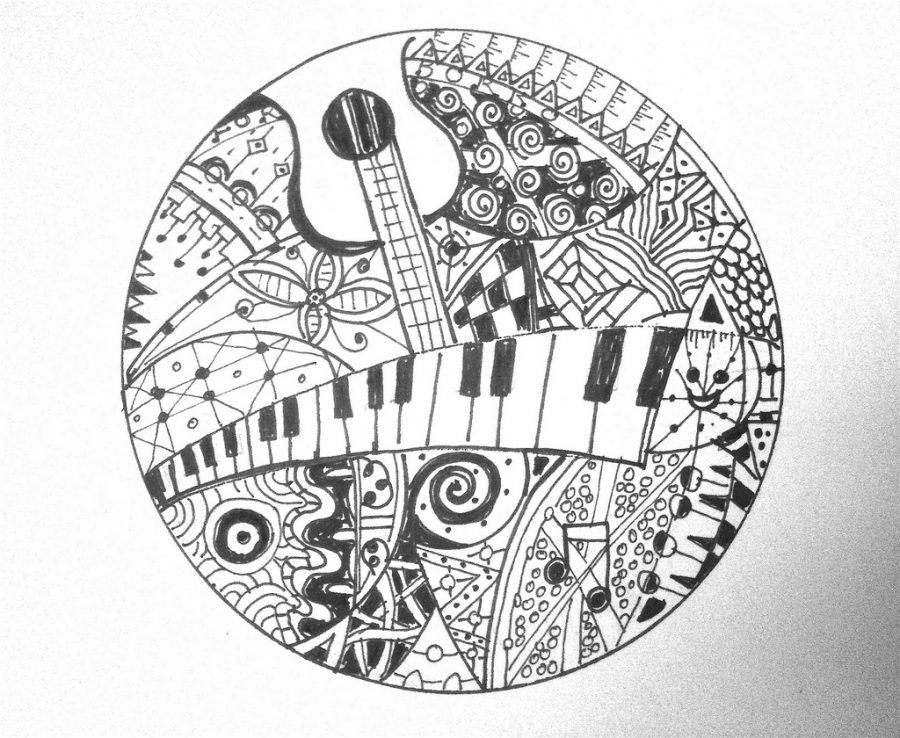The creative way of learning
Research destroys the popular belief of doodling’s effects
A doodle of musical instruments
“I’m not a history person, so paying attention in class is a difficult task for me because it requires my full effort,” said sophomore Max Kovach. “However, it dawned on me that when I doodle, I retain more information so I started doing it more often.” Although Kovach is in his humanities class, he often finds himself doodling his dream cars which he said still helps him regardless if it’s related to the class lecture or not.
Doodling, as defined by the Cambridge Dictionary, is a drawing or pattern that you make while thinking about something else or when you are bored. Not exactly untrue, many students and business persons tend to doodle when a lecture or presentation becomes too slow and dull.
However, over the years, doodling has earned a bad rap because many think that it’s a tool for distraction. Special education teacher Tinky Schmit said that she thinks doodling can be distracting. She said that she is okay with students doodling if she notices them paying attention even while doodling. “But sometimes it can cause disruption for others,” she said.
In spite of popular belief, though, there’s more to doodling than just absentmindedly drawing.
A study published in 2009 in the journal Applied Cognitive Psychology shows that simultaneously doodling and listening is effective in regards to paying attention and obtaining information. In the study by psychologist Jackie Andrade of the University of Plymouth, 40 participants were asked to listen to a 2½-minute rambling voicemail about several topics including a birthday party and the guest list.
The first 20 participants were asked to switch from doodling and writing down the names of the guests while the other 20 were asked to just write down the names, without doodling. After the experiment, the papers were taken from the participants and they were asked to recall the names of the guests. Those who were asked to switch between doodling and writing remembered 29 percent more of the information than those who were asked to simply take notes.
Andrade theorized that doodling and listening actually goes hand-in-hand since doodling employs the brain’s “executive resources” which helps with planning, concentration and multitasking.
As a matter of fact, it’s not only ordinary students who doodle. Even former American presidents such as Theodore Roosevelt, Ronald Reagan and John F. Kennedy have spent time in the meeting room doodling away. Medical students also have confessed that doodling helps them focus especially since they have to digest large amounts of information.
Senior Patricia Cardeno said that in her church teen advisory group, they often draw images of their future plans for the group. “We actually enforce doodling because it provides a visual aide to many of us and it sometimes gives us fun ideas for future plans,” Cardeno said. “Not everyone are just listeners; some learn better and get more creative ideas through visuals and doodles are exactly that.”
And believe it or not, paying continuous attention actually strains the brain, so doodling is a perfect method to give the brain some break.
The process of intently paying attention and then doodling can be compared to the concept of focused thinking and diffused thinking. Focused thinking is straightforward and self-explanatory — it’s when a person attentively listen to the matter at hand. Diffused thinking, on the other hand, is a form of learning where a person does other things or slips into a relaxed yet creative state of mind that wanders freely. It can take the form of going on a run outside, taking a shower, or in the case of students, business persons, and former presidents, doodling.
Aside from the cognitive benefits of doodling, it also acts as a tool to relieve psychological distress. Doodles have been used by Dr. Robert Burns, the former director of the Institute for Human Development at the University of Seattle, to diagnose emotional problems. Burns believe that doodles provide an individual insight and can reveal what’s happening in the unconscious. An experiment was also conducted which revealed that the participants evoked positive emotions through art-making, specifically doodling.
Senior Tiana Hovsepians who is aspiring to become an art major sees doodling as a therapeutic act to distress. “Sketching can be stressing sometimes because it is planned and strategic while doodling is just drawing whatever comes to your mind,” Hovsepians said. “So it’s nice and relaxing that I can still do what I love because doodling doesn’t have to be perfect like with sketching and it also takes my mind off things— it’s practically my stress outlet.”
In addition, spontaneous drawings keeps many people in the present moment instead of zoning out and daydreaming. Jesse Prinz, a philosophy professor at City University of New York Graduate Center, stated that doodling is in the middle of listening to too much and listening to too little. Prinz also explained that doodling helps individuals to see the bigger picture of things since focusing too attentively could likely lead to the person overthinking and paying too much attention to details.
AP Psychology teacher Patrick Davarhanian said that he sees the gain in doodling. Although he doesn’t doodle himself, Davarhanian said that he lets his students do whatever helps them learn better. “It’s beneficial in regards to that it’s similar to fidget spinner,” Davarhanian said. “So for people who might have difficulties focusing and paying attention, if they utilize the doodling or those other instances it can help them better focus on the task at hand.”

Interests/Hobbies: fashion, reading, fangirling, reading, doing artsy stuff, reading, reading, reading
Favorite year in music: 18th century-21st...













